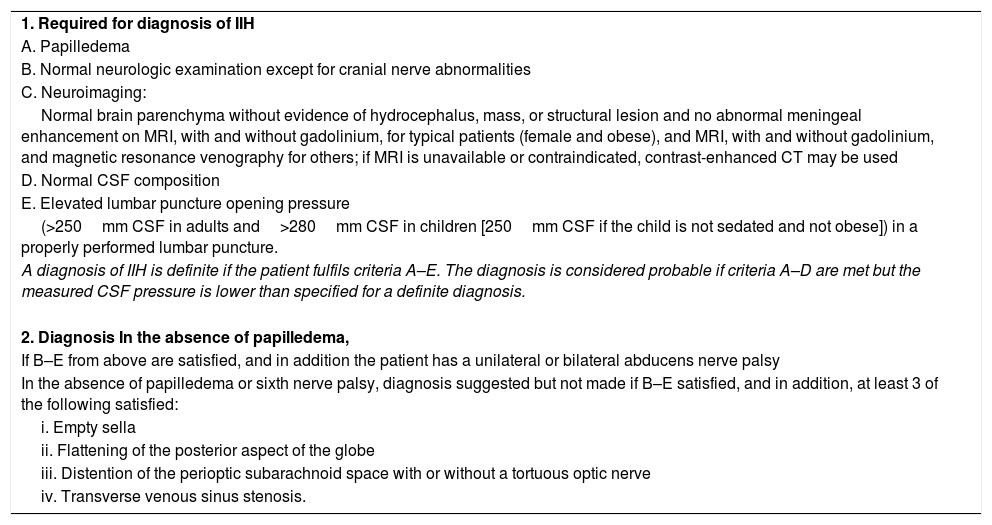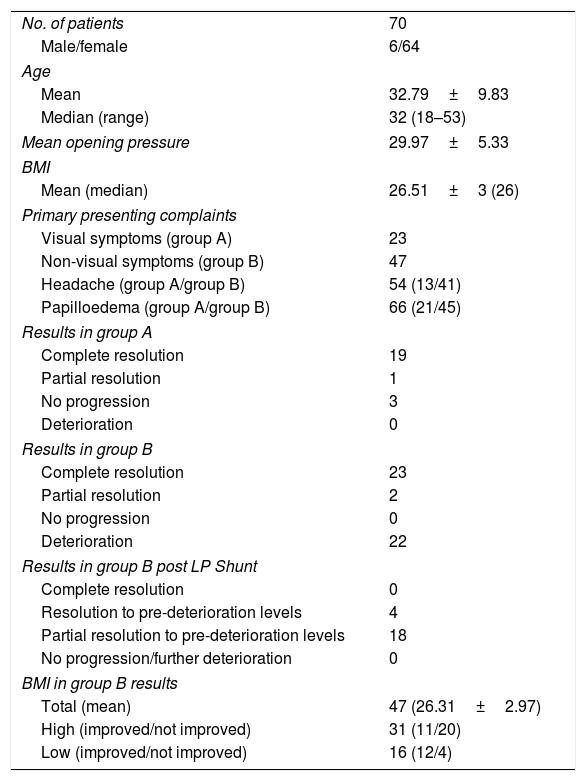To evaluate the efficacy of lumbo-peritoneal shunt (LPS) in patients of idiopathic intracranial hypertension presenting with visual symptoms.
MethodsBetween Apr. 2014 and Mar. 2018, 70 patients of Idiopathic Intracranial Hypertension (IIH) underwent treatment at our institution. Patients were evaluated for neurological and ophthalmological status and were subjected to LPS depending on their symptoms.
ResultsMean opening pressure was 29.97±5.33cm of water and mean Body-Mass Index (BMI) was 26.51±3 and the two were significantly correlated (p-value 0.006). All patients with visual symptoms (23) underwent LPS and others (47) were managed medically. All patients with LPS and 25 of medically managed patients improved, while 22 medically-managed patients required LPS due to deterioration in visual symptomatology. The proportion of patients showing complete resolution of features of IIH was significantly different between the three groups. Of the 7 patients with shunt extrusion/migration, only 2 required revision.
ConclusionLPS is an equally effective and more technically familiar modality for treatment of IIH for neurosurgeons and should be offered to asymptomatic patients with objective visual signs. Shunt extrusion/migration may not always warrant revision due to “mini-shunt” that drains Cerebro-Spinal Fluid (CSF) through shunt tract even after extrusion.
Evaluar la eficacia de la derivación lumboperitoneal (DLP) en pacientes con hipertensión intracraneal idiopática con síntomas visuales.
MétodosEntre abril de 2014 y marzo de 2018, 70 pacientes con hipertensión intracraneal idiopática (HII) se sometieron a tratamiento en nuestra institución. Los pacientes se evaluaron para determinar el estado neurológico y oftalmológico y se sometieron a DLP en función de sus síntomas.
ResultadosLa presión de apertura media fue de 29,97±5,33cm de agua y el índice de masa corporal (IMC) medio fue de 26,51±3, y los 2 presentaron una correlación significativa (valor de p=0,006). Todos los pacientes con síntomas visuales (23) se sometieron a DLP y otros (47) recibieron tratamiento farmacológico. Todos los pacientes con DLP y 23 de los pacientes que recibieron tratamiento farmacológico mejoraron, mientras que 22 pacientes con tratamiento farmacológico precisaron DLP debido al deterioro en la sintomatología visual. La proporción de los pacientes que mostró resolución completa de las características de la HII fue significativamente diferente entre los 3 grupos. De los 7 pacientes con extrusión/migración de la derivación, solo 2 precisaron revisión.
ConclusiónLa DLP es una modalidad igual de eficaz y más familiar desde un punto de vista técnico para los neurocirujanos para el tratamiento de la HII y debe ofrecerse a los pacientes asintomáticos con signos visuales objetivos. La extrusión/migración de la derivación puede no justificar siempre una revisión debido a la «miniderivación» que drena el líquido cefalorraquídeo (LCR) a través del conducto de derivación incluso después de la extrusión.
Artículo

Si es la primera vez que accede a la web puede obtener sus claves de acceso poniéndose en contacto con Elsevier España en suscripciones@elsevier.com o a través de su teléfono de Atención al Cliente 902 88 87 40 si llama desde territorio español o del +34 932 418 800 (de 9 a 18h., GMT + 1) si lo hace desde el extranjero.
Si ya tiene sus datos de acceso, clique aquí.
Si olvidó su clave de acceso puede recuperarla clicando aquí y seleccionando la opción "He olvidado mi contraseña".










